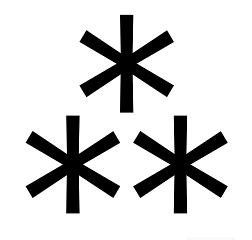-
3-minute read
-
24th September 2020
7 Unusual Punctuation Marks You Never Knew Existed
Did you think punctuation was complicated enough? Well, today, the 24th of September, is National Punctuation Day in the USA! And to celebrate, we thought we’d share some of our favourite unusual punctuation marks.
1. Interrobang
We’re starting off with a bang – an interrobang. This punctuation mark combines a question mark (?) and an exclamation mark (!). You can, thus, use it to show excitement or disbelief when asking a question:
What are all these weird punctuation marks‽
While you can use a question mark and an exclamation mark separately to a similar effect, we think the interrobang looks much cooler.
2. Asterism
In astronomy, an asterism is a pattern or a group of stars. In the wonderful world of punctuation, though, an asterism is three asterisk marks (*) arranged in a triangle. It’s also known as a triple asterisk.

People have used asterisms to mark part of a text, or to indicate minor breaks (e.g. scene changes within a chapter in a novel). But this punctuation mark is rare these days, with a line of three or more asterisks more common.
3. Percontation Point
The percontation point was first suggested in the late 1500s by Henry Denham, an English printer. A reversed question mark, he intended it to be used at the end of a rhetorical question, like this:
Who cares about the percontation point⸮
It is now also referred to as a ‘rhetorical question mark’. But, sadly for Denham, it never really caught on beyond a few punctuation nerds (like us).
4. Irony Mark
The French author Herve Bazin proposed six new punctuation marks, one of which was an irony mark. It looks like the Greek letter psi (ψ) with a dot below it. His idea was that the irony mark would be placed at the start of a sentence to tell you that it should be read as ironic.
Find this useful?
Subscribe to our newsletter and get writing tips from our editors straight to your inbox.
Subscribe to Beyond the Margins and get your monthly fix of editorial strategy, workflow tips, and real-world examples from content leaders.
Bazin wasn’t alone in thinking we need a way to denote irony in writing. Several other symbols have been proposed to this end, including the percontation point above, but none of them have really taken off.
5. Conviction Point
Bazin also suggested the conviction point. This symbol, an exclamation point with a line through it, is used to end sentences with conviction. And while we’re not sure, we assume this means that you’re certain about something but not excited enough to use an exclamation point instead.
Not one we would recommend for your writing, incidentally – rather than stressing your certainty, it’s likely to cause confusion among most readers!
6. Doubt Point
We’ll give Bazin credit for covering every situation: if you aren’t writing with conviction, you might need to use his doubt point instead. The opposite of the conviction point, ending a sentence with this will express scepticism.

7. Hedera
Last, but not least, is the hedera. ‘Hedera’ means ‘ivy’ in Latin, and you can see why this punctuation mark was named after the plant.

This symbol was used in Latin and Greek texts as a paragraph divider. And given how intricate it is, it’s not surprising that it’s hardly used any more, especially in handwritten texts like they would have been at the time!
Do you have a favourite unusual punctuation mark? Let us know in the comments below! And if you would like an expert to check you have used punctuation correctly in a piece of writing, whether it’s commas, quotation marks or even asterisms, our proofreaders can help.




